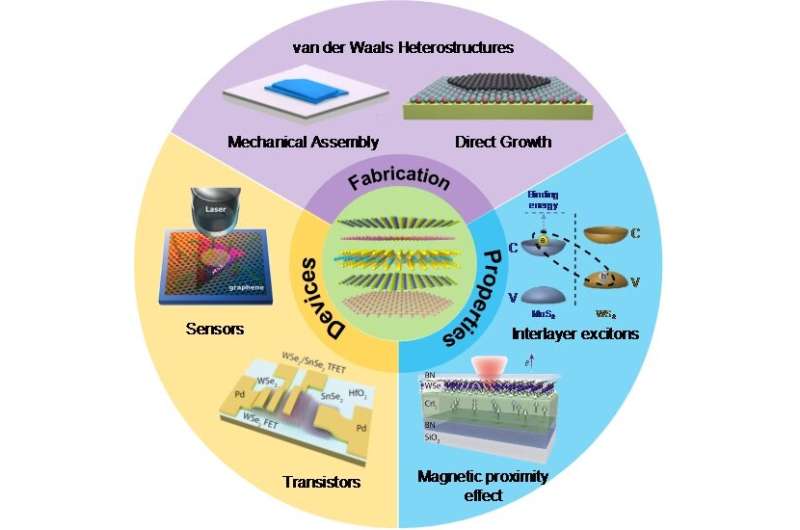Recent progress in fabrication methods (direct growth and mechanical exfoliation), material properties (optical, magnetic, and electrical properties), and device applications (FETs, photovoltaic devices, sensors, memory devices, and mechanical resonators) of 2D vdW HSs. Credit: Science China Press
Two-dimensional van der Waals heterostructures (2D vdW HSs) can be constructed by stacking different 2D materials together in nearly endless ways, and have significantly enriched the 2D materials family. They have attracted significant attention due to their exotic physical properties and intriguing device performance, often beyond those found in their constituent 2D materials.
2D vdW HSs provide new platforms to explore novel physical phenomena, and offer new opportunities for enabling next generation 2D devices. In this review, the researchers survey recent progress in fabrication methods, material properties, and device applications of 2D vdW HSs, and offer their perspectives on future research directions.
Fabrication: There are various methods to fabricate 2D vdW HSs, which can be categorized into two categories: direct growth and mechanical assembly. By far, chemical vapor deposition (CVD) and physical vapor deposition (PVD) methods are the most commonly used techniques for direct growth of 2D HSs. The article surveys several mainstream techniques of fabricating 2D vdW HSs based on direct growth and mechanical assembly.
Properties: Not only do 2D HS systems inherit the properties of their constituent 2D layers, they also offer new degrees of freedom by combing different 2D materials through endless ways. Therefore, 2D HSs are excellent platforms for exploring and investigating exquisite physical phenomena, such as magnetic proximity effect, interlayer excitons, etc. The article surveys and discusses a few examples of the optical, magnetic, and electrical properties in 2D HSs.
Applications: The intriguing material properties discussed above make these 2D vdW HSs of great promise for creating atomically thin devices, such as field-effect transistors (FETs), photovoltaic devices, sensors, memory devices, and mechanical resonators. The article discusses several types of vdW HSs-based devices and their potential applications.
Conclusion and outlook: While this family of 2D structures exhibits many exceptional properties and intriguing devices performance, further studies on 2D vdW HSs still face important challenges, and several scientific questions remain unexplored. This offers new opportunities for 2D HS study that can potentially lead to important breakthroughs. This review discusses a few such examples: further development of growth techniques, investigation of twistronics in 2D HSs beyond twisted bilayer graphene, and exploration of 2D magnetic memory devices.
The research was published in Science China Information Sciences.
More information: Zenghui Wang et al, Recent progress in 2D van der Waals heterostructures: fabrication, properties, and applications, Science China Information Sciences (2022). DOI: 10.1007/s11432-021-3432-6
Provided by Science China Press
























